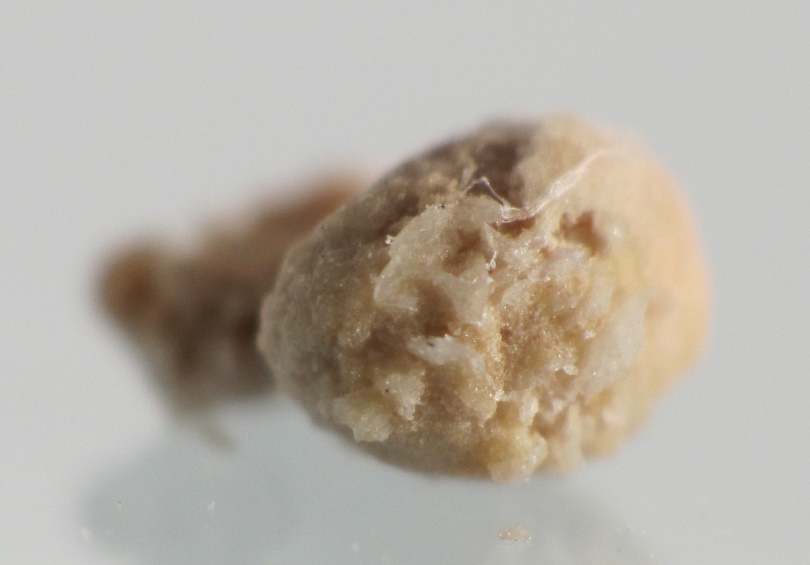The recent approval of Nedosiran (RIVFLOZATM) by the FDA was another landmark moment in the field of hyperoxaluria. Hyperoxaluria is increased hepatic oxalate production, leading to recurrent calcium oxalate kidney stones.
| What are kidney stones? | Image of a kidney stone. |
| Kidney stones are hard objects made up from chemicals in the urine. According to the Kidney Stone Foundation, the prevalence of kidney stones in the United States has increased from 3.8% to 8.8% in the period from the late 1970s to the late 2000s. Approximately 9% of women and 11% of men have a risk of developing kidney stones. | 
(Soure: WIKI commons) |
Primary hyperoxaluria is an inherited defect of oxalate metabolism that can lead to recurrent renal stones, nephrocalcinosis, and eventually end-stage renal disease.
The small interfering RNA (siRNA) therapy for treating primary hyperoxaluria was developed by Dicerna Pharmaceuticals, now a Novo Nordisk company. In the US, Nedosiran received its first approval on 29 September 2023.
Nedosiran lowers urinary oxalate levels in children aged nine and younger than nine years and adults with primary hyperoxaluria type 1 (PH1) and relatively preserved kidney function.
PH is a family of autosomal recessive genetic disorders characterized by excessive oxalate synthesis in the liver. Excess oxalate leads to insoluble calcium oxalate crystals in the kidneys and the development of kidney stones.
The liver enzyme lactate dehydrogenase (LDH) encoded by the LDHA gene catalyzes the conversion of glyoxylate to oxalate in liver cells. This reaction is the last step of oxalate formation in the liver. Reducing LDH by inhibiting LDHA with RNA interference therapies is a promising treatment strategy for all subtypes of PH.
Following the approval of Lumasiran, Nedosiran is the second siRNA approved for the treatment of PH1. Unlike Nedosiran, Lumasiran inhibits glycolate oxidase to decrease glyoxylate overproduction in peroxisomes.
Current synthesis technologies allow the production of short oligonucleotide complexes 21 to 27 nucleotides in size. In addition, the synthesis of therapeutic siRNAs containing specific chemical modifications is now also possible. Once synthesized, siRNAs are delivered and evaluated for their activities and drug properties in vitro and in vivo models.
The first therapeutic siRNA approved by the FDA in August 2018 was Patisiran. Patisiran is a therapeutic for the treatment of hereditary transthyretin amyloidosis. In this autosomal dominant disease, the accumulation of misfolded TTR protein throughout the body results in progressive neuropathy, cardiomyopathy, and ophthalmic disease, among other end‐organ effects.
Reference
Bhasin B, Ürekli HM, Atta MG. Primary and secondary hyperoxaluria: Understanding the enigma. World J Nephrol. 2015 May 6;4(2):235-44.[PMC]
Febina, M B. Nedosiran: The rescue from hyperoxaluria. Amrita Journal of Medicine 20(1):p 44-46, January-March 2024. [AJM]
Forbes TA, Brown BD, Lai C. Therapeutic RNA interference: A novel approach to the treatment of primary hyperoxaluria. Br J Clin Pharmacol. 2022 Jun;88(6):2525-2538. [PMC]
National Kidney Foundation [Kidney.org]
Syed YY. Nedosiran: First Approval. Drugs. 2023 Dec;83(18):1729-1733. doi: 10.1007/s40265-023-01976-4. Erratum in: Drugs. 2024 Jan 22. [PMC]
---...---
" Bio-Synthesis provides a full spectrum of high quality custom oligonucleotide modification services including 5'-triphosphate and back-bone modifications, conjugation to fatty acids, biotinylation by direct solid-phase chemical synthesis or enzyme-assisted approaches to obtain artificially modified oligonucleotides, such as BNA antisense oligonucleotides, mRNAs or siRNAs, containing a natural or modified backbone, as well as base, sugar and internucleotide linkages.
Bio-Synthesis also provides biotinylated mRNA and long circular oligonucleotides".
---...---